
Grândola is a town (vila) and municipality in Setúbal District in Portugal. The population in 2011 was 14,826, in an area of 825.94 km2.

Linha da Beira Baixa, originally called Caminho de Ferro da Beira Baixa, is a railway line which connects the stations of Entroncamento and Guarda in central Portugal. The first section, from Abrantes to Covilhã was opened on 6 September 1891. The line to Guarda was opened on 11 May 1893. At the time, only the section from Abrantes to Guarda was considered to be part of Linha da Beira Baixa, while the route from Entroncamento to Abrantes belonged to the Linha do Leste. Passenger service on the Guarda-Covilhã segment reopened on 2 May 2021 after it fell into disuse in 2009.
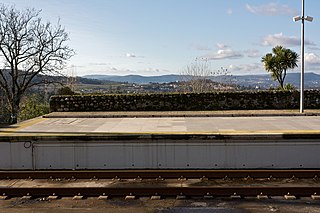
Ramal de Braga is a branch line in Portugal, which connects Nine railway station on the Linha do Minho, with Braga. It was opened on 21 May 1875. and modernised in 2004.
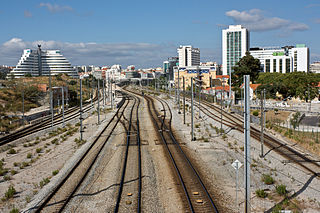
The Cintura Line is a railway line in Lisbon, Portugal. The half circle route was opened in 1888 and serves as a connection between all railway lines in Lisbon: The Cascais, Sul, Sintra, and Norte Lines. There are two railway triangles, one in Sete Rios, and another in Xabregas. It crosses all four Lisbon Metro lines, and connects to three of those at four stations.

Linha de Leixões, also known as Linha de Cintura do Porto, is a freight railway line which connects Contumil railway station, on the Linha do Minho, and Leixões, in Matosinhos, Portugal. It was opened in 1938, and electrified in 1998. Passenger services ran until 1987 and from 2009 to 2011.

Linha do Leste is a Portuguese railway line which connects Abrantes railway station to the border with Spain, near to Elvas. The connection to Spain was opened on 24 September 1863.

Ramal de Maceira-Liz is a freight railway line in Portugal which connects the railway station of Martingança, on the Linha do Oeste, to the cement factory Maceira-Liz.

Ramal de Neves-Corvo is a railway branch in Portugal, which connects the station of Ourique, on the Linha do Alentejo, to the Neves-Corvo mine.
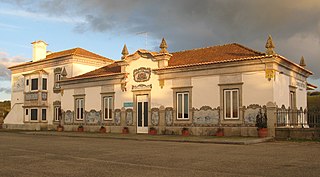
Ramal de Portalegre, originally called Linha de Portalegre, is a closed railway line which connected the stations of Estremoz, on the Linha de Évora, and Portalegre, on the Linha do Leste. It was planned to connect Estremoz to Castelo de Vide, on the Ramal de Cáceres, but the railway was only built to Portalegre-Gare. The line was opened on 21 January 1949, and closed in 1990.

Ramal de Reguengos, originally called Linha do Guadiana, was a railway branch line which connected the stations of Évora and Reguengos de Monsaraz, in Portugal. It was opened on 6 April 1927.

Ramal de Rio Maior was a Portuguese branch line which connected the station of Vale de Santarém, on the Linha do Norte, to the Espadanal mines, in Rio Maior.

Ramal de São Roque was a Portuguese branch line which connected the station of Aveiro, on the Linha do Norte, to the Canal de São Roque.

Ramal da Siderurgia Nacional is a Portuguese freight railway line which connects the station of Coina to the industrial complex of Siderurgia Nacional. The line opened in March 2008.

Linha de Sines is a railway line which connects the station of Ermidas-Sado, on the Linha do Sul, to the Port of Sines, in Portugal. It used to be connected to the station of Sines via a branch line. The first section, from Ermidas-Sado to São Bartolomeu da Serra was opened on 9 April 1927. The line reached Cumeadas on 1 July 1929, Santiago do Cacém on 20 June 1934, and Sines on 14 September 1936.
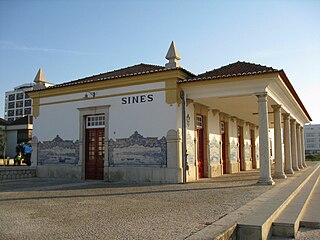
Ramal de Sines is a closed railway branch line which connected the stations of Ortiga, on the Linha de Sines, and Sines, in Portugal. It was opened 14 September 1936.
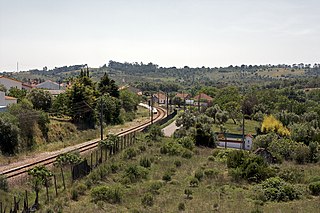
Ramal de Tomar is a Portuguese railway line which connects the stations of Lamarosa, on the Linha do Norte, and Tomar. It was opened on 24 September 1928.
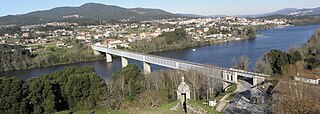
Ramal Internacional de Valença is an international railway line which connects the stations of Valença, in Portugal, and Guillarei, in Galicia (Spain). It was opened on 25 March 1886.
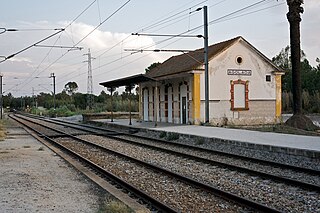
Linha de Vendas Novas is a freight railway line which connects the stations of Setil, on the Linha do Norte, and Vendas Novas, on the Linha do Alentejo, in Portugal. It was opened on 15 January 1904. This line also previously had a regional passenger service which operated until 2005, then again between 2009 and 2011. Passenger service on this line was discontinued due to low ridership.

Ramal de Viana-Doca is a closed Portuguese railway branch line which connected the station of Viana do Castelo to the city's port. It was opened on 20 March 1924 and closed in mid-1988.

The Cave of Pego do Diabo is a small karst cave in a Turonian limestone outcrop located about 250 metres above sea level in the municipality of Loures, about 20 km north of Lisbon in Portugal. The erosion of the outcrop resulted in a set of openings in the rocks wide enough to be exploited by humans. Several archaeological studies have been conducted within the cave, which give insights into the duration of Neanderthal presence on the Iberian Peninsula and to the presence of carnivorous animals during the Paleolithic.
















